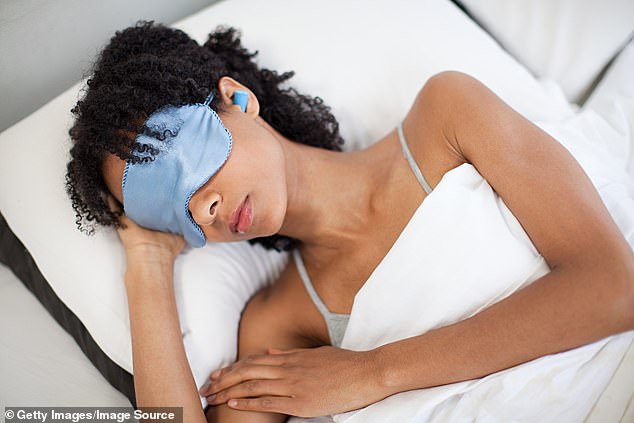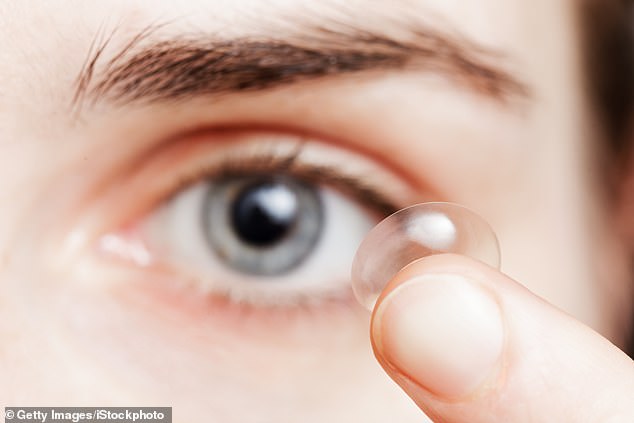Using earplugs to block out noise can damage hearing, experts warn (and contact lenses and dentures can also cause health problems)
From dentures to contact lenses and mouthguards, there are many accessories that we put in our ears, eyes, nose or mouth to promote well-being. But can they also cause problems? ANGELA ESTEIN asked the experts…
MOUTHPIECES CAN CAUSE TOOTH CASE
MANY people who have lost some or all of their teeth end up wearing dentures: removable dentures.
But can these in themselves cause problems? When researchers at Cardiff University took mouth, tongue and denture swabs from hospital patients with pneumonia and compared them with samples from healthy denture wearers, they found that not regularly cleaning dentures increased the risk of pneumonia, the Journal reported or Medical Microbiology. last year.
The theory is that dentures provide a surface for disease-causing organisms to colonize before traveling to the lungs via saliva.
As London-based dentist Charles Ferber explains, the mouth provides the perfect warm and moist environment for bacteria and fungi to thrive. It’s vital, he adds, to have good oral hygiene: brushing teeth twice a day with fluoride and flossing so that plaque or food particles don’t get between the dentures and the teeth.

Earplugs should be removed just before bedtime and replaced with disposable earplugs after a few days
Likewise, he recommends taking out the dentures and cleaning them twice a day with a special toothbrush and a non-abrasive cleaner.
Do this over a bowl of water or a towel, in case you break them or drop them into the plug hole. He also suggests asking your dentist or dental hygienist if your dentures can be cleaned with their practice’s ultrasonic cleaner (which is used to clean dental equipment).
Meanwhile, bite guards that prevent nighttime teeth grinding (also called bruxism) can also become a breeding ground for bacteria that can cause tooth decay and gum disease, as well as sore throats, nausea, flu and respiratory infections, says Charles Ferber.
He explains: ‘They are usually made of acrylic, which has a rough surface, making it easy for bacteria to adhere. Hold them under water and clean them with a toothbrush and toothpaste.’
HEARING AIDS CAUSE INFECTIONS
Hearing aids worn in the ear act like a plug, keeping air out and creating a warm and moist environment in which bacterial and fungal infections can flourish in the ear canal, the tube that runs from the outer ear to the eardrum. So it’s important to take a break from wearing them, explains Professor Simon Lloyd, a consultant ear, nose and throat (ENT) surgeon at Manchester Royal Infirmary.
Regular nighttime use of earplugs can push earwax into your ear, causing hearing problems.
‘It is better not to plug the ears for long periods of time as the humidity in the ear rises and this can make you more susceptible to infections,’ says Nicholas Eynon-Lewis, an ENT specialist at St John & St Elizabeth Hospital in London.
He recommends removing them just before bedtime and replacing disposable ones after a few days. If they become stuck, which is rare but can happen with long-term use, they can become lodged deep in the ear canal and you may need to see an ENT surgeon for removal. Earplugs for music or conversations worn in the ear, when used at high volumes, can pose a risk to hearing and cause tinnitus, due to damage to the hair cells in the inner ear.
A recent international study in the BMJ found that teenagers and young people are at serious risk of hearing loss if they listen to music at volumes as high as 105 decibels. The safe limit is 80 decibels for adults, while for children it is 75.
Long-term use can also push earwax into the ear and cause blockage, a common cause of temporary hearing loss. And because of the damp, moist, airless environment caused by the ‘clogging of the ear’ they can lead to an ear infection. Clean the earplugs with an alcohol wipe.


Sleeping with the contact lenses in place can increase the risk of eye infections eightfold
LENSES COUPLED TO LOSS OF VISION
Contact lenses float on a thin layer of tears on the cornea – the transparent front part of the eye. Good hygiene is crucial to prevent serious problems. A 2022 study by Moorfields Eye Hospital in London found that people who wore reusable contact lenses (changed monthly, usually made of silicone hydrogel) were almost four times as likely as those who wore daily lenses (also made of silicone hydrogel) to develop acanthamoeba keratitis. develop – a painful infection of the cornea that can lead to vision loss.
It is caused by exposure to amoebae found in water sources such as swimming pools and tap water.
‘Never use tap water to clean reusable lenses, only use sterile saline solution,’ explains Jeff Kwartz, consultant ophthalmologist at Royal Bolton Hospital.
“I have seen cases that have resulted in severe scarring, blindness, corneal transplantation and even eye removal.”
There is also a risk of damage to the cornea: a scratch in the eye with your nail, when putting in or taking out lenses.
And according to a 2018 study from the Centers for Disease Control and Prevention in the US, sleeping with contact lenses on can increase the risk of eye infections eightfold. ‘The safest way to use contact lenses is with a daily disposable lens,’ adds Mr Kwartz.
Snoring device AND NOSEBLEEDS
About 40 percent of adults in Britain snore while sleeping.
One solution is to use a nasal dilator: a small flexible plastic device placed in the nose to keep the nostrils open, making it easier to breathe.
Mr Eynon-Lewis says: ‘But be careful not to push them too far up the nose as this can cause nosebleeds and inflammation.’
